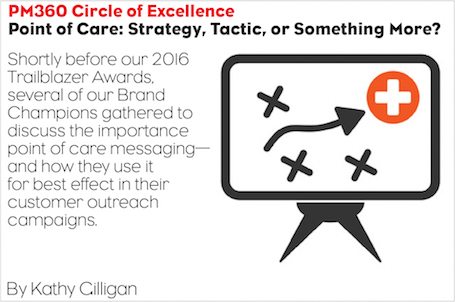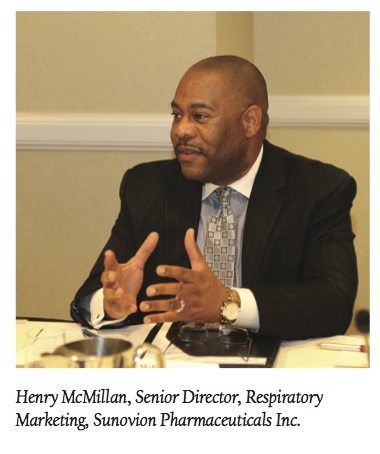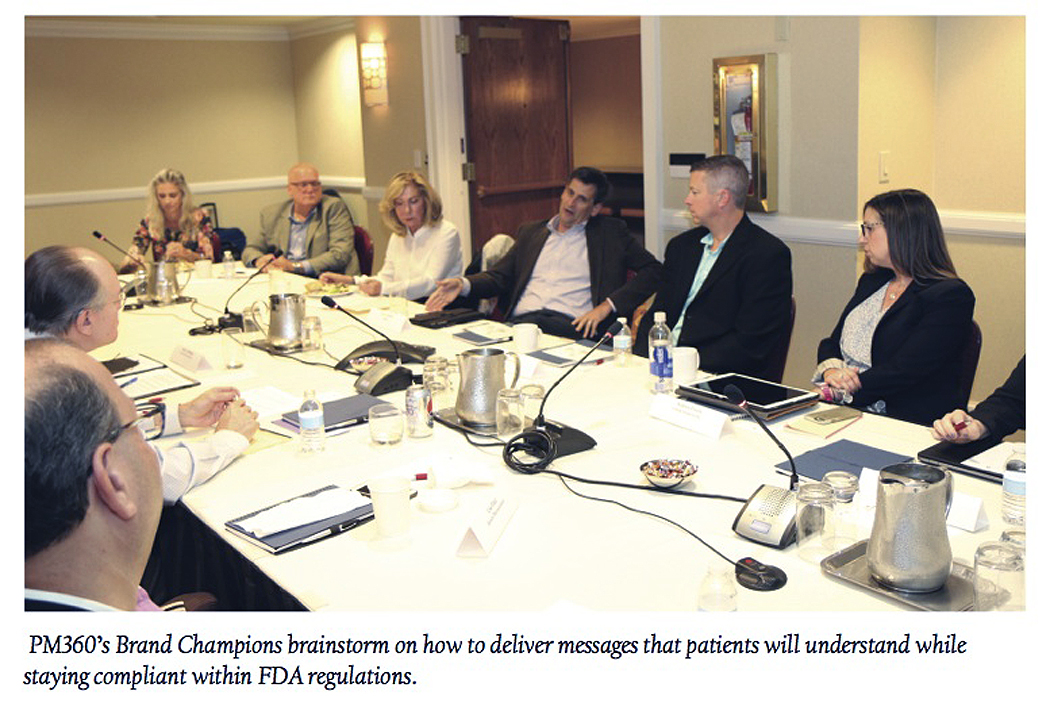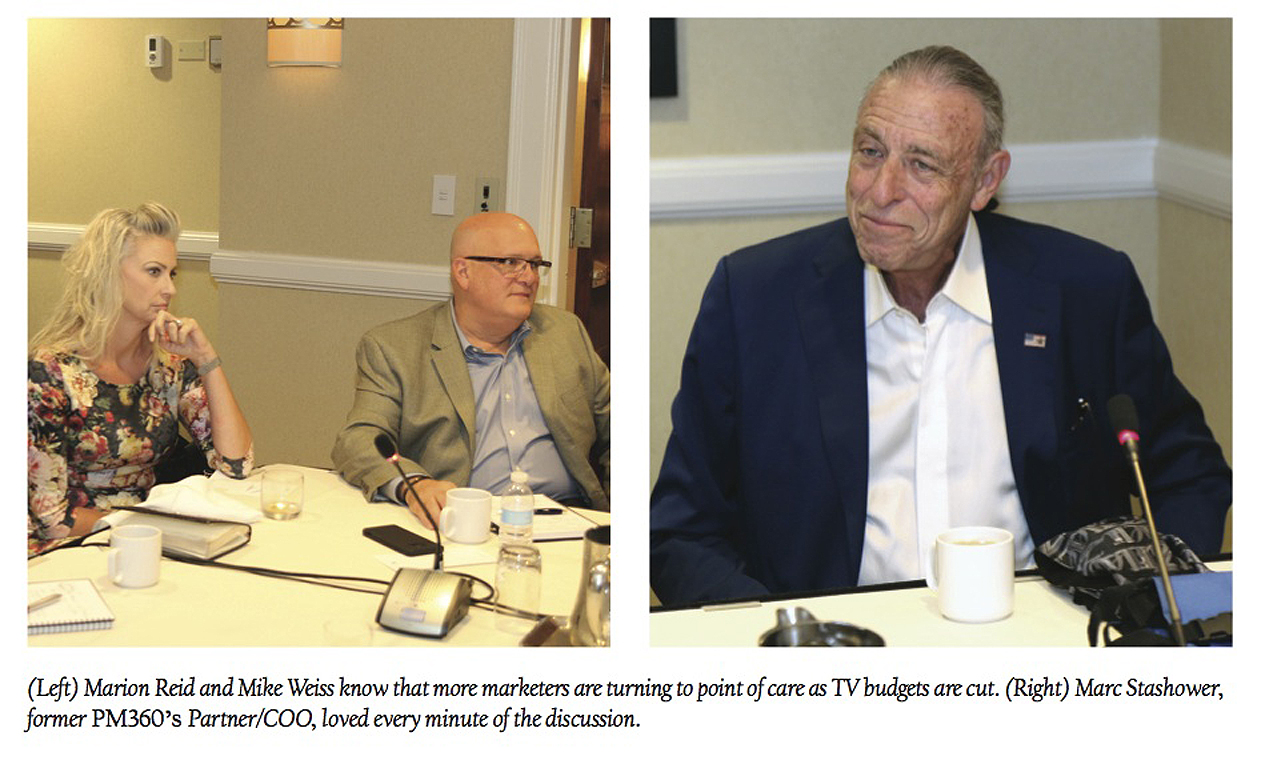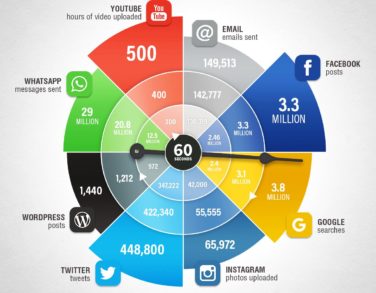Several of PM360’s 2016 Brand Champion Award Winners gathered before the Trailblazers Awards Gala last year to discuss the many ways that point of care marketing is used to educate and engage patients, HCPs, NPs, PAs, and others to improve brand success and patient outcomes.
PM360’s Success Coach columnist, Bud Bilanich, moderated the event. Participants included:
- Kevin Bell, Former Marketing Director, Diabetes Oral Brands, AstraZeneca
- Lisa Flaiz, Group Product Director, Digital Marketing, Janssen
- Henry McMillan, Senior Director, Respiratory Marketing, Sunovion Pharmaceuticals Inc.
- Andrea Porzio, Director, HCV Marketing, Gilead Sciences
- Catharine Sanders, Patient Engagement Lead – IBD, UCB
- Chris Saunders Sr. Director – HCP Lead, Neuroscience Business Unit, Shire
- Matthew Tucker, Senior Director, Specialty Marketing, Mylan
Participants from Health Monitor Network, who sponsored the Brand Champion Roundtable, included Ken Freirich, President; Mike Weiss, Vice President of Sales; Dan Tassone, Director of Strategy and Integrated Solutions; and Marion Reid, Sales Director.
Bud Bilanich: We’re here to talk about point of care marketing today and how you use it in your marketing mix to engage patients during the patient journey. To start, I will turn to Ken Freirich, President of Health Monitor Network, our sponsor. Ken, can you start by telling us a little about your company and your thoughts on point of care?
Ken Freirich: First, I’d like to welcome all the 2016 Brand Champions to this roundtable. With respect to our discussion today, we’ve been in the point of care space for 33 years. Our base of experience stems from relationships with more than 200,000 offices, 368,000 HCPs, and tens of millions of patients. We have many different perspectives on patients, doctors, patient/physician dialogue, and so forth. It’s great to sit peer-to-peer and talk about things that matter and that ultimately affect patients every day. So, during this discussion, any time that I can be helpful, I’ll certainly chime in.
Bud Bilanich: Thank you, Ken. Let’s talk about what everyone is doing in direct to consumer, and then we’ll talk more specifically about point of care. Lisa, would you like to tell us what you are doing at Janssen?
Lisa Flaiz: I am focused on creating excellent customer experiences in the digital channel. When it comes to DTC, it’s a predominantly digital world, whether it’s our brand dotcoms, search campaigns, media, display media campaigns, social, or mobile.
So one of my mantras is that the presentation of information is just as important as the information itself. You have to be able to find it, read it, understand it, and enjoy it, to learn. My job is ensuring that our content is engaging, compelling, and relevant.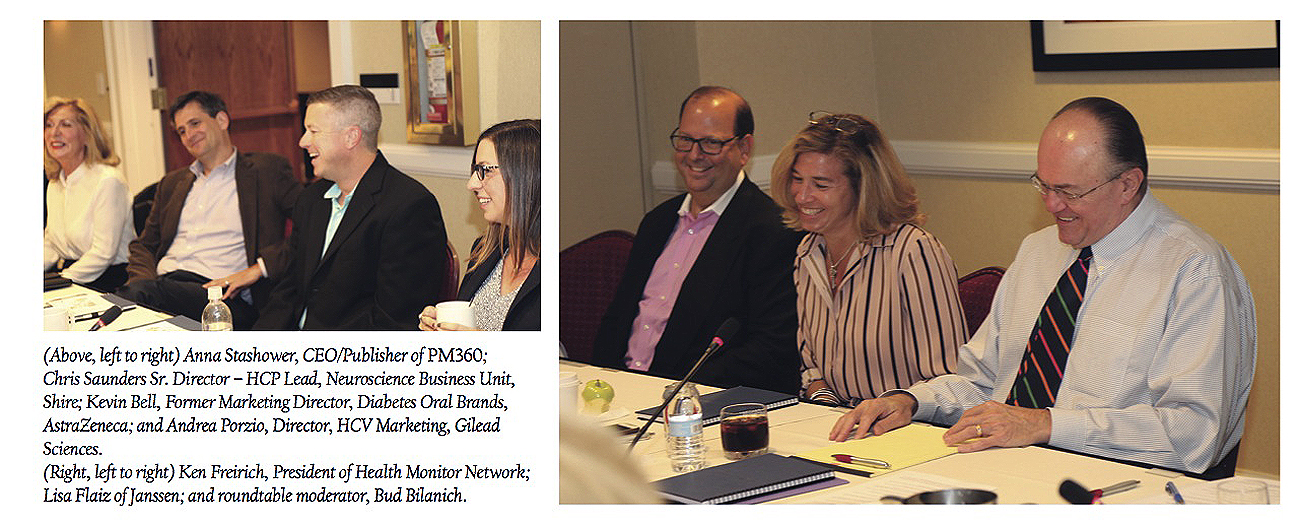
Bud Bilanich: Matthew, what are you doing at Mylan?
Matthew Tucker: Within the specialty side, we do a number of point of care and DTC activities for a variety of different categories. And a big piece of the puzzle is disease state awareness. We drill down to apply different adult learning principles to have an effect. In disease state awareness, you deal with more technical things. We have products that use a device for delivery. The barrier is using the delivery device, such as a nebulizer or an auto injector, to ensure the medication works effectively.
So we need to drill down to a very technical level. The struggle is often measuring and understanding the effectiveness of our communications.
Bud Bilanich: Catharine, can you talk about UCB?
Catharine Sanders: We focus on serious, chronic conditions, including Crohn’s disease. With patient education, our focus is on finding the right marketing mix to reach people living with chronic disease in a very authentic way that truly connects with them. The emotional, psychosocial, and nutritional needs of the Crohn’s disease patient, for example, are extraordinary. And so our commitment is really to deliver value to the patient.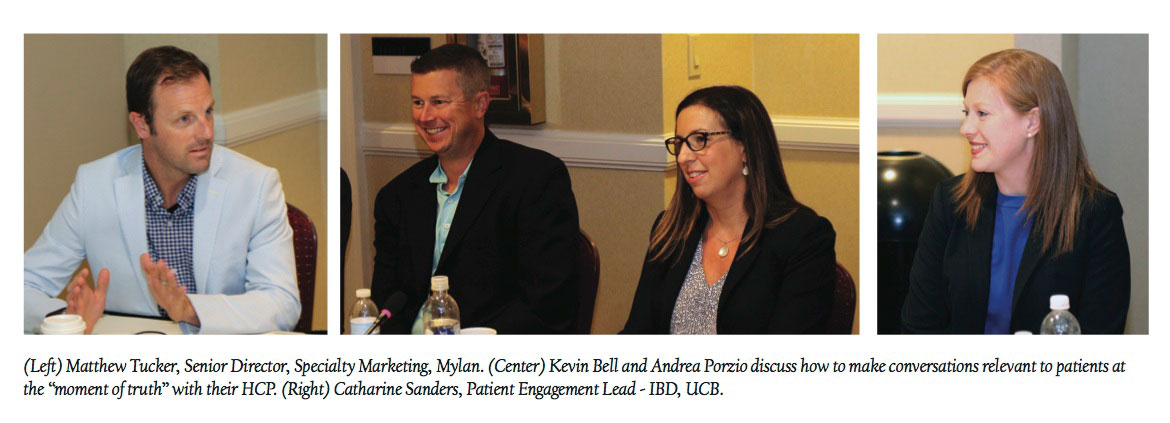
Bud Bilanich: Andrea, what are you doing at Gilead?
Andrea Porzio: Since Hepatitis C historically has been surrounded with a lot of stigma, we had to break the inertia in this category. Upon the launch of our franchise, we knew we had to activate the patients in this category in a different way than perhaps what was done historically. The channels we have used to activate patients are diverse, and along the way we have leveraged a lot of point of care and believe it plays a strong role, but also see it as a compliment to many other channels that DTC can offer. Different channels can play different roles depending on the market you work in.
Because we work in a cure market, there is a constant need to continue to focus on patient acquisition (vs. retention). Our challenge resides in the fact that many people living with Hep C don’t know they have it, so our efforts span from early disease state education that lets patients know they are at risk for Hep C to activating patients who have been living with the disease for decades but didn’t know they could be treated and potentially cured. It’s our goal to support patients to have a confident conversation with their HCP to help determine what is right for them. To do that well, we need to think carefully on how we leverage tried and true consumer channels, as well as new ones, which at times means thinking a bit non-traditionally.
Bud Bilanich: Great. Thank you. Kevin?
Kevin Bell: My former company, AstraZeneca, is known for its work in chronic conditions and large-scale products. We used DTC to engage and educate patients so they will be more engaged in the management of their disease—and it fosters a much better discussion with the physician. We saw it on both HCP and on the consumer side, through EHR work, as well as point of care.
Bud Bilanich: Chris, what are you doing at Shire with DTC and point of care?
Chris Saunders: I’ll talk about eating disorders, and in DTC, a couple of things come to mind. The first: It was a brand new disease category in 2013—and we’re at the forefront. We’ve approached it with three precepts, but first, with a deep understanding of the patient journey. We could intervene in many different places, so much of what we do is making the right choices as to where to intervene.
Second, it is a mobile world for most patients. That’s a real driver for us. Finally, when we launched, celebrity Monica Seles was our spokesperson. We did a lot of disease state TV advertising. As I said, our job is choosing where and how to intervene.
So it’s about a patient who is dealing with a stigmatized condition, understanding that, and then creating environments in which the patient can say, “I might have binge eating disorder.” And then, get them to talk with their doctor. But we have to understand the high leverage points, and deploy the full range of materials and strategies.
Bud Bilanich: Henry, can you talk about Sunovion?
Henry McMillan: I’ve been in respiratory for over a decade, particularly in COPD. In that market, physicians believe a certain set of delivery devices are better for patients. But when you talk to the patients, you hear a different story. So how do you manage that disconnect?
Is there an opportunity at that point of care to facilitate the physician dialogue with patients, particularly older patients, who typically do what the doctor suggests? Also very key: Engaging the caregivers—providing an opportunity to structure the discussion and that visit differently.
And what of the outcome? If a device doesn’t allow patients to administer the medication appropriately, they still need to be treated appropriately. In some respects direct to patient, particularly point of care, is more impactful, because it’s targeted at that moment when the discussion is taking place.
Ken Freirich: In terms of a channel, we refer frequently to that as the “moment of care.” Everything you do builds up to that conversation. That’s an opportunity to make sure that you’re at that last step.
Catharine Sanders: We think about the patient’s psyche in that moment of meeting in the HCP office, when they are going into the office. People are busy with the various details of their day-to-day lives and not necessarily thinking about what they’re going to talk about with the doctor when they get there.
How do we reach them to facilitate an empowered point of care conversation, even before they get to the actual point of care? We have tools including doctor discussion guides, but what more can our industry do?
Bud Bilanich: That’s a great question. Anyone want to answer?
Henry McMillan: You need to know who’s influencing the patient journey and making decisions. What type of information do they use to make decisions? Based on that, step back and understand where you can put good, unbiased, disease-based information and ensure that information is accepted and used. We work with both advocacy groups and academic groups together.
Ken Freirich: I’ll add that the ability to engage advocacy level association, and the continued relationships patients have with other HCPs and doctors, the NPs, and the PAs, is very important. We’ve worked with associations, and in particular, the NPs or PAs are the gatekeepers to patient education.
Henry McMillan: Right. So where the information comes from is very important. Patients want to hear from their doctor, but the doctor doesn’t have the time. So more in-depth discussions have to take place with either the office staff or the NP. To ensure that happens, you’ve got to build out your program to involve other caregivers and give them the rationale as to why you’re sharing this with them. On the ROI side, it’s a challenge. But sometimes you just have to make the investment.
Bud Bilanich: Andrea, you were looking forward to the ROI discussion. What are your thoughts on that?
Andrea Porzio: Coming into this discussion, I read a statement that mentioned point of care is proven to have the highest ROI against all the other channels, and I haven’t seen that, and would be curious as to what others have seen.
Bud Bilanich: So in terms of ROI, you are saying TV commercials are a highly effective strategy, and rather than adding more spend to more efficient, targeted, and segmented communications provided by POC, this provides better ROI. Is that what you are saying?
Andrea Porzio: I don’t know that many other channels can replicate what TV does, and I firmly believe that. As mentioned, I do think point of care clearly has a place in the mix, but I align with what Catharine was saying: People need to be prepared before they get to that very critical conversation with their HCP, that “moment of truth,” because sometimes you get that moment just once. Helping the patient be prepared and engaged in their health in advance of that discussion is important.
We can’t expect someone to run through the entire patient journey in a few minutes with somebody they may be seeing for the first time. As you all know, it takes a while to get patients to come back around again, especially if you’re in a specialty category. I don’t believe TV will get it done on its own. We need to use other channels to pull through messages and tailor messages appropriately for different points in time on that patient journey.
Ken Freirich: So, in terms of figuring out the where and the when to engage patients at the point of care, we can oversimplify: The moment of care is where everything happens. You’ve got to be there, because if you miss your opportunity to get your brand in front of the patient, they’ll never go on therapy. But what we’ve seen is they may engage in dialogue in the office. An NP, PA, or a caregiver can play a role, too.
Kevin Bell: Much of the hurdle is behavioral. Until we address the behavioral issue, for instance, when people feel bad about bothering their HCP to say they don’t feel well, everything we do will underperform and underserve the patients. The takeaway for marketers: How do I spend more time addressing behavior? Caregivers become very important in this situation.
Andrea Porzio: Yes, I would agree. It’s the basics around tailoring communications and the insights that need to go into those unique communications for different channels. That should come before you get into the channel discussion.
Kevin Bell: The “where” you do it, right?
Andrea Porzio: Before the “where,” you have to figure out what the unmet need is—what’s going to make that conversation even relevant to patients.
Bud Bilanich: Great. As Kevin noted, point of care for one patient could actually lead to awareness for another, in this case, the caregiver?
Catharine Sanders: Mass media is a great way to instigate that process, before you can reach patients at a point of care. And yes, there is that amplification effect when reaching out to the caregiver, too.
We also need to continue thinking about ways to connect patients directly with other patients because that is the most authentic voice. As marketers, we can never tell as compelling a story or give as compelling an argument for why a particular treatment works as someone who’s actually experienced it. So even with point of care, we should challenge ourselves to look for ways to connect to that genuine patient voice.
Bud Bilanich: So in point of care, if patients can hear from other patients that are going through the same thing, then that addresses the point just mentioned, right?
Lisa Flaiz: I’ll add that it’s not just on the industry to help educate people to participate in their own healthcare. The healthcare shift is placing the burden on the participant—the phrase “participatory medicine” didn’t exist five years ago. Physicians are working with Triple Aim, increasing patient satisfaction, and improving the patient experience. Lowering the healthcare dollar is going to motivate the physicians to do a better job, patients to do a better job because they’re paying more, and it’s certainly motivating the payers to do a better job.
Ken Freirich: Yes, and that has changed the delivery systems. Physicians know that patient satisfaction and improving outcomes enhances their bottom lines, and that of their large group practice, or IDNs, or integrated networks. That’s the financial incentive.
Henry McMillan: To your point, Ken, the relationships are changing. So retail pharmacy is working with hospitals now. There are hospital-owned retail pharmacies, etc. Different folks, IDNs, are taking on insurance. Since relationships are changing, we need to change, too. Their needs are different. You’ve got to provide a solution that’s going to help.
Bud Bilanich: Kevin, you look like you want to add to this.
Kevin Bell: And then there is FDA monitoring. One of the challenges we face lies in giving the patient the “so what” in a way they truly understand. From a branded perspective, Opdivo’s ad was a game changer. They said, “live longer.” That’s what the cancer patient cares about. They don’t care about rates or comparisons with other treatments. They just want to live longer. That’s the conversation that we should be having.
Chris Saunders: What you say about being able to explain the “so what” is very interesting. Different people have varying perspectives regarding what the FDA finds acceptable or unacceptable. I can give simple, factual statements. I can put that in front of HCPs and count on them connecting those dots. Patients can’t do that. That’s why that conversation has to be front of mind when we talk with an HCP. We have to let them facilitate that patient conversation to point out the “so what.”
Kevin Bell: Yes. The onus is then on us to do it the right way. We can’t try to sneak in some brand messaging. It’s got to truly be about the patient.
Chris Saunders: It has to be from the heart.
Kevin Bell: From the heart. It has to be educational and beneficial in the management of their disease.
Andrea Porzio: I’ll just add that as marketers, we have to inspire people, and we have to write materials in a way that they can understand it. I think that’s our responsibility—and that’s, I think, why a lot of us are in this business.
Henry McMillan: And, to add to that, if you look at the FDA’s mission, it is to ensure public safety. They should say for instance, if you have diabetes, these are the things that are important. Your hemoglobin, A1C, etc. You should talk to your doctor about these things. And with your medication, these are the things you want to check. It’s unbiased information.
Then, you let industry have the discussion. For example, you communicate to patients that, as you’ve heard, these things are what is important, and then this is what our drug provides. Now you’ve given a point of authority and the responsibility to communicate what’s key in an unbiased way.
Bud Bilanich: And if we go back to what Kevin was saying about Opdivo—facts don’t necessarily do as well as emotion channeled in a positive way that says, “We want you to live longer.”
Chris Saunders: I think we have to make both rational and emotional arguments to all of our customers. We’re very good at treating doctors as rational people and give them data and information because we believe in evidence-based medicine. It’s important—they make many decisions based on rational facts and numbers.
But we also do need to connect to the doctor’s emotional side—how you treat them. Patients are the same. The emotional or rational approach and engagement differs by audience or disease category. But when you engage, you must find out what they’re talking about, and then you deliver both. At the core, when you talk to patients emotionally, the truth and the trust is based on fact-based communication that’s well-grounded in credible, viable science and information.
Ken Freirich: That gets to the point about pre-point of care, and as you mentioned, Opdivo. That’s pre-point of care, which prepares the patient for having a good conversation with the physician. The core is a motivated patient. If patients have a good relationship with an HCP, a doctor, or NP, it’s likely they’ll continue treatment.
Henry McMillan: I agree, and I think you have to structure your teams differently, too. To get to deeper insight, you need someone who can keep every project moving forward, but he may not be able to go deep. You must have someone who’s going to go very deep on the issues to get real critical insight, and then bring it forward. We have to ask if we have really put teams together so that someone can fill that role.
Bud Bilanich: Good question. Who would like to answer?
Catharine Sanders: Well, we’ve been taking a very grassroots approach. We’re talking live human to human. It’s all about meeting people when they want to hear about your brand, because at the point of care, we’re battling human nature. The challenge: Going to the doctor is stressful. You’re worried. You’re tense. That conversation is never going to be as productive as you’d like.
We’ve taken that approach with a very grassroots campaign, partnering with advocacy, reaching consumers, loved ones, and people living with the condition, at a moment when they are truly engaged because they want to learn and want to know about your brand.
While human nature just can’t be overemphasized, we also need to challenge ourselves to evaluate, from a rational business perspective, where you are going to have an impact. Point of care can mean something very different for some disease states versus others.
Bud Bilanich: That’s true, so how does everyone view point of care? Do you see point of care as a strategic or tactical decision?
Henry McMillan: I think point of care is strategic, because you need to put effort into a particular audience to support a goal. How I do that is tactical. So what tactics do I develop to support that? If I believe that point of care messaging is relevant in my disease space, then that’s strategy. How you do it is what becomes tactical.
Catharine Sanders: Point of care is an element of the marketing mix. It’s scalable. It depends on what you’re trying to accomplish. If you look at the traditional framework of goal, objective, strategy, tactic—what is it you’re trying to do, and where do you need to be to do that?
It’s part of your marketing mix. And then you can start evaluating ROI across those channels, across that mix of tactics.
Bud Bilanich: Very good. Ken would you like to add anything as we wrap up our conversation?
Ken Freirich: To sum it up, the nature of how point of care companies, as a group, approach these offices shapes the dynamic you work in. Some are more aggressive than others. But in terms of a marketing mix—and I’ve seen this traditionally over the years—when big brands launch, depending on where they are in the lifecycle, how the company is performing, earnings, etc., if they can, they typically do it all. But eventually TV may be cut, and what I’ve seen often is that people go to point of care.
The other element is the health system ACO. We’ve seen that over time practices are being bought out. That affects how you approach any office and it affects your group, because now you have managed care, and closed systems, and through point of care, they’re allowing our educational materials in exclusively. That is particularly important to know as the healthcare landscape continues to change.

